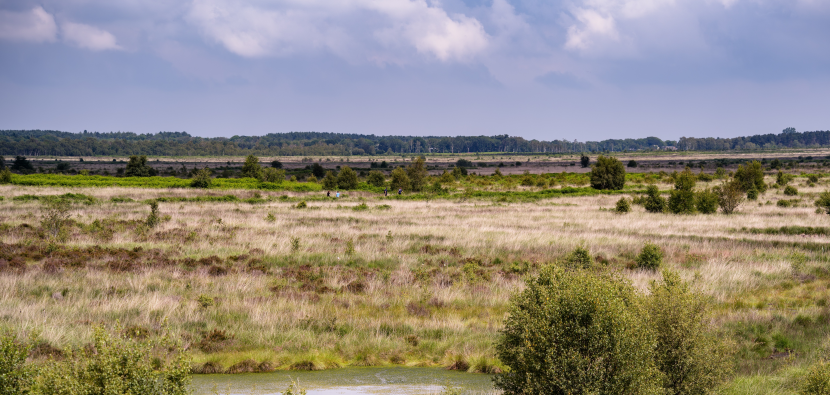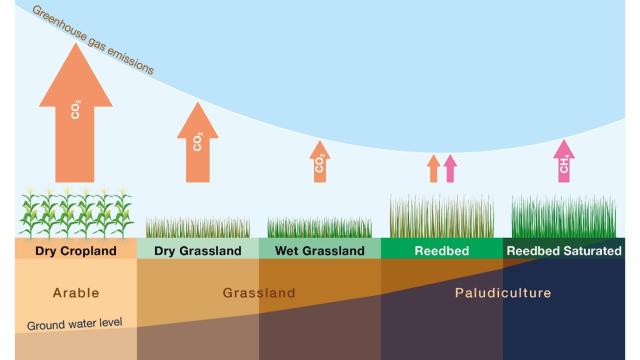
Sustainable peatland management: a guide for farmers
Peatlands play a crucial role in supporting ecosystems, mitigating climate change, and ensuring long-term agricultural viability. However, their degradation due to drainage, intensive farming, and climate change, threatens their ability to store carbon, support biodiversity, and provide benefits for the water environment.
Effective peatland management involves balancing agricultural productivity with environmental conservation. Farmers have a unique opportunity to adopt sustainable practices to boost soil health, encourage nature’s recovery, and contribute to the UK’s climate commitments. This article provides practical guidance on managing peat soils responsibly, highlighting key strategies for improving peatland condition while maintaining a viable farm business.
Why peatland management matters
Peatlands are the world's largest terrestrial carbon store, holding more than twice as much carbon as all the world's forests combined. A key indicator of healthy peatland condition is its water content. However, when drained for agriculture, oxidation takes place within the peat soils and the organic matter decomposes, releasing carbon dioxide into the atmosphere, contributing to climate change, and leading to land subsidence.
Degraded peatlands represent a net carbon source, whilst healthy peatlands store, and can even sequester, carbon over time. Globally, peatlands form 3% of land cover, yet hold over 500 gigatonnes of carbon. In England, emissions from peat soils are approximately 2% of England’s total GHG emissions, and approximately 88% of peat emissions come from the lowlands.
Sustainable management is therefore essential to preserving their ability to provide multiple ecosystem services.
Key reasons for sustainable peatland management include:
Carbon storage – Healthy peatlands store carbon, helping to mitigate greenhouse gas emissions.
Biodiversity – Peatlands provide unique habitats for rare species.
Flood mitigation – Maintaining healthy peatlands helps regulate water flow, reducing flood risks.
Water quality – When healthy, peatland habitats can provide natural filtration, reducing coloration and removing nutrients.
Soil longevity – Degradation through drainage leads to loss of soil and organic matter, impacting long-term agricultural productivity.
Currently, only 13% of UK peatlands remain in a near-natural state, with this figure dropping to just 1% in lowland areas. Effective management strategies can help restore these vital landscapes and ensure they remain productive for future generations.
Key approaches to sustainable peatland management
Understanding the impact of drainage
Drainage is one of the most significant threats to peatlands, particularly in the lowlands. When peat dries out, oxidation releases stored carbon, resulting in ongoing land loss. For instance, intensively farmed peatlands can subside by over 2 cm per year.
Raising the water table helps slow this process. Research shows increasing the water level by just 10 cm can reduce carbon emissions by up to 5 tonnes of CO2 per hectare per year. However, water management must be carefully controlled to avoid flooding risks and maintain agricultural viability.
Implementing water table management
Managing water tables is crucial to maintaining peatland health while allowing for continued farming. Key techniques include:

Controlled rewetting – Raising water tables incrementally to balance soil moisture retention and land usability.
Drainage modifications – Blocking or adjusting ditches to improve water retention and prevent excess runoff.
Seasonal water storage – Storing water in wetter months for use during drier periods.
Image 1: Optimal water table depth for climate change mitigation
Finding the optimal water table depth is essential. For instance, raising water levels to 60 cm below the surface can reduce emissions while having relatively low impact on crop yields. More significant rewetting may necessitate alternative land uses such as paludiculture.
Exploring paludiculture as an alternative farming system
Paludiculture is a farming system designed for rewetted peatlands, involving growing crops that thrive in high water table conditions. This approach reduces peatland degradation while maintaining agricultural productivity.
Examples of wetland crops include:
Reed grasses – Used for bioenergy, building materials or animal bedding.
Sphagnum moss – A sustainable alternative to horticultural peat.
Blueberries and cranberries – Crops that naturally grow in wet conditions.
By shifting toward paludiculture, farmers can diversify income streams while contributing to carbon reduction goals and improving peatland resilience against climate change.
Balancing restoration with agricultural productivity:
Full peatland restoration may not always be feasible due to economic constraints, food security needs, or the condition of existing soils. However, a balanced approach can be achieved by:
Creating mosaic landscapes – Combining restored peatland with areas of sustainable farming.
Adopting higher water table farming – Maintaining a water table closer to the surface while growing suitable crops.
Using agri-environment funding – Leveraging financial incentives to support transition efforts.
For example, the Countryside Stewardship Higher Tier scheme offers payments for raising water levels in lowland arable and grassland peat soils, helping offset costs associated with high water table management.
Collaborating with stakeholders
Effective peatland management requires cooperation between farmers, landowners, water authorities, and conservation organisations. Key considerations include:
Hydrology impacts – Ensuring water table adjustments do not negatively affect neighbouring lands.
Regulatory compliance – Working with Natural England, Environment Agency and other bodies to secure necessary permits and support when applying for CSHT.
Community engagement – Discussing land management changes with local stakeholders to ensure mutual benefits.
By fostering collaboration, farmers can access technical support, financial resources, and knowledge-sharing networks that facilitate sustainable peatland management.
Financial incentives and support
Several funding opportunities are available to support peatland-friendly farming practices, including:
Countryside Stewardship Higher Tier (CSHT) – Grants for rewetting and habitat restoration, as well as capital payments to support preparation.
Carbon credit schemes – Payments for maintaining or restoring peatlands as carbon sinks.
Private investment initiatives – Partnerships with businesses seeking to offset carbon footprints.
These financial mechanisms help to cover the costs of transitioning to sustainable peatland management while ensuring long-term economic and environmental benefits.
The take-away:
Peatlands are a vital resource for farming, nature and climate resilience. While the transition to sustainable peatland management presents challenges, the long-term benefits—ranging from carbon storage and flood risk mitigation to improved soil sustainability—far outweigh the costs.
Farmers have a crucial role in ensuring peat soils remain productive while reducing emissions and enhancing biodiversity. By implementing improved water management, exploring alternative farming techniques like paludiculture, and utilising financial incentives, farms with peat soils can thrive while contributing to national climate goals.
